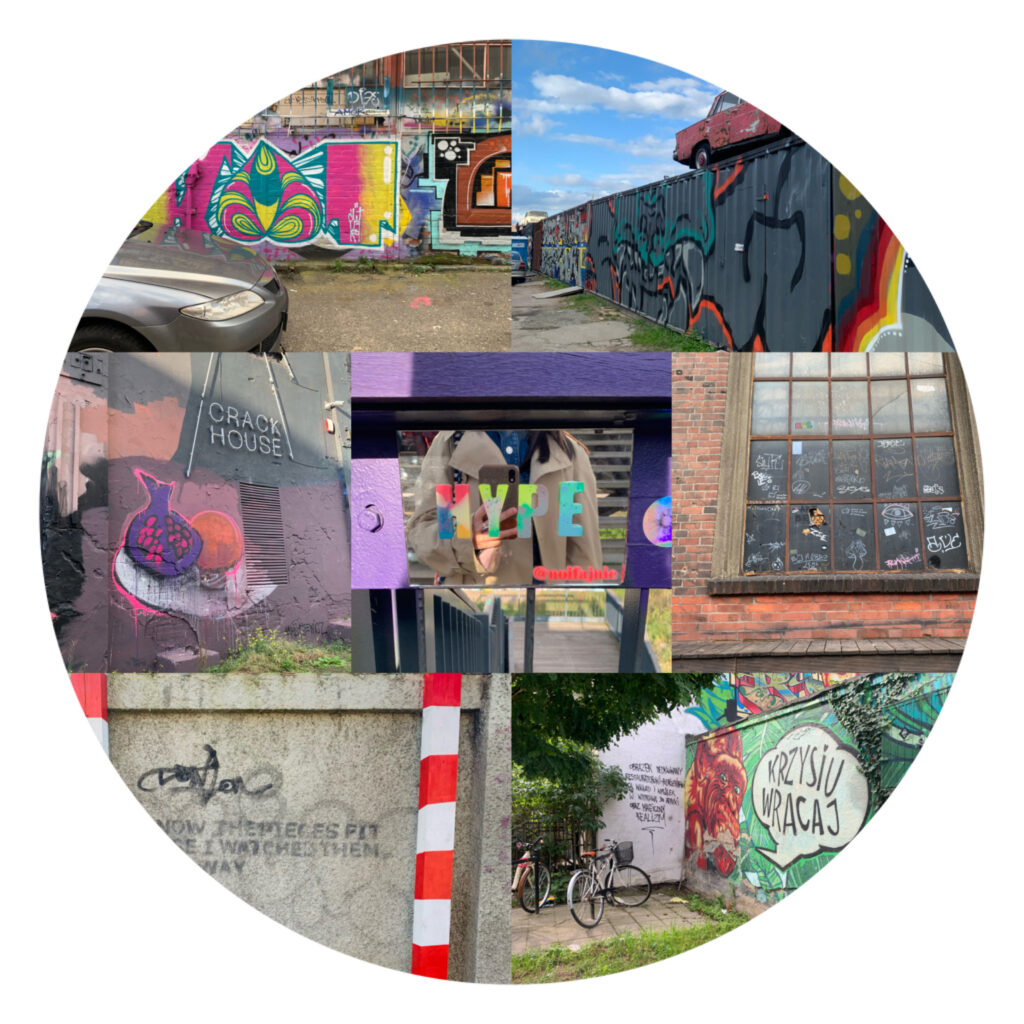
( English and Chinese versions below )
„Wiem, że kawałki pasują, bo
Patrzyłem jak odpadają”.
– Graffiti przy stacji Gdańsk Oliwa
Spacerując po Sopocie, Gdańsku czy Gdyni nietrudno o ślady graffiti, wlepek i sztuki ulicznej. Czasem można je znaleźć na szczycie parkowego pawilonu, na suficie peronu kolejki SKM, są jak ślady głosów. Podczas moich podróży często mam wrażenie, że te głosy są jak niewidzialne fale, płynące w wielu kierunkach przez Trójmiasto, nieustannie rozszerzające się, wahające i wibrujące, jakby wzywały i czekały na spotkanie z nimi.
Pamiętam, że pewien profesor powiedział kiedyś, że graffiti miasta jest jak głosy jego duchów. Anonimowe, milczące, a jednak posiadające historie i pragnące być usłyszane. Ponieważ narracja i przestrzeń są kodowane przez władzę (polityka języka i przestrzeni), ulice stają się dla nich ostatnimi schronieniami, które mogą “nawiedzić” – używając swoich sposobów artykułowania życia i rzeczywistości, które nie są legitymizowane przez struktury. Choć głosy te mogą być ignorowane, marginalizowane i uciskane na powierzchni, zawsze będą wracać i nie rozwieją się.
Ściana Lennona w Hongkongu została usunięta, ale wydaje się, że nie zniknęła. Z tego powodu, być może, przyszłam pod mury Polski, aby być świadkiem – aby zostać zabraną do wcześniejszego czasu historii ludzkości, aby zrozumieć. Historie muru berlińskiego i praskiego muru Lennona to właściwie mniej niż pięćdziesiąt lat. Jedyne sześć lat temu Trump twierdził, że zbuduje “wielki, piękny mur” między USA a Meksykiem. Podczas ruchów społecznych i wojen w ostatnich latach internet i wiadomości są często blokowane przez rząd – czyż nie są to znacznie bardziej zaawansowane, wszechobecne i brutalne mury?
Patrząc na ślady wymazywania i ukrywania, czasami zastanawiam się: czy mury funkcjonują jako ochrona, określając granice i terytoria, czy też popychają ludzi do dwóch polaryzujących skrajności? Kogo chronią, a kogo wykluczają? Czy pewnego dnia, gdy dialogi staną się całkowicie dysfunkcyjne, grafficiarze również zostaną wymazani – tak jak graffiti? Kto definiuje i utrzymuje linie, które oddzielają ludzi? Komu daliśmy władzę decydowania o światach wewnątrz i na zewnątrz murów?
“I know the pieces fit because
I watched them fall away”.
— A Graffiti near the Gdańsk Oliwa Station
Walking in Sopot, Gdańsk and Gdynia, it is not difficult to find traces of graffiti, stickers and street arts. Sometimes, you can even find them on top of the park pavilion, on the ceiling of the SKM train platform, like footprints of voices. On my journeys, I often have the feeling that these voices are like invisible waves, flowing in multiple directions across the Tricity, incessantly extending, fluctuating and vibrating, as if they are calling and waiting for the eyes to meet them.
I remember a professor once said, the graffiti of a city is like the voices of its ghosts. Anonymous, silent, yet have stories and desires to be heard. As narrative and space are coded with power (the politics of language and space), streets become the last shelters for them to “haunt” — using their ways to articulate lives and realities that are not legitimated by the structures. Although these voices may be ignored, marginalized and oppressed on the surface, they will always come back and will not dissipate.
The Lennon Wall in Hong Kong has been removed, but it never seem to vanish. Because of this reason, perhaps, I have come to the walls of Poland, to witness — to want to be taken back to the earlier time of human history, to want to understand. The histories of the Berlin Wall and the Prague Lennon Wall are actually less than fifty years ago. It was only six years ago that Trump claimed to build a “big beautiful wall” between the U.S. and Mexico. During the social movements and wars in recent years, the internet and news are often blocked by the government — aren’t they the much more advanced, all-pervasive and violent walls?
Looking at the traces of erasure and concealment on the walls, sometimes I wonder: are the walls functioning as protection, defining borders and territories, or are they pushing people to two polarizing extreme ends? Who are they protecting and excluding? One day, when dialogues become completely dysfunctional, will the graffitiers also be wiped out — like how they do to the graffiti? Who defines and maintains the lines that separate people? Who have we given the power to decide the worlds inside and outside the walls?
”I know the pieces fit because I watched them fall away”.
—— 在Gdańsk Oliwa車站附近的一塗鴉字
在波蘭Sopot、Gdańsk和Gdynia三個城市行走的時候,不難發現街上各處都充斥着塗鴉、貼紙和街畫。有時,甚至在公園的涼亭頂,火車的月台天花,都能看到聲音的足跡。行走的時候,常有種感覺,這些聲音就像無形的海浪一樣,在城市的不同空間多方向流動、穿梭、一直伸延、連綿不絕的波動和振動,彷彿在呼喚和等待能夠與他們眼睛對上的有緣人。
記得以前一位教授說過,城市的塗鴉就像鬼魂的聲音一樣,雖無名無姓,卻有力量,有故事,渴望被看見。因為言語和空間是有權力符號 (the politics of language and space),所以刻在牆上,反抗約束的塗鴉,彷彿就是要展示,被忽視、邊緣化和壓迫的聲音,雖然能一時的清除,但終將會一直回來,不會消散。
香港的連儂牆消失了,但又好像從沒離開。或因如此,來到了波蘭的牆面前,讓它們如流水一樣,把我帶到更早的人類歷史前。往後走,柏林圍牆和布拉格連儂牆,其實並不是超過五十年前發生的事。往近一點看,還記得當時美國總統川普聲言要建一幅 “big beautiful wall” 去分隔美國和墨西哥。而看看當下,近年在不同國家發生社會運動時,隨時可被中斷的網絡和新聞,又是不是,更先進、無孔不入而暴力的牆壁?
在波蘭的三聯市裡行走,有時看著牆上被抹去、被覆蓋的痕跡,不知何解,會疑惑 ——— 圍牆是保護,是分隔,抑或是一道又一道把人們越推往兩極的無形之手?當有天,社會的對話完全失效時,也許就是塗鴉者直接被抹走?分隔人們的線,到底是由誰去定義,由誰去維持?我們又給了誰資格和權利,去判斷牆內牆外的進出?

